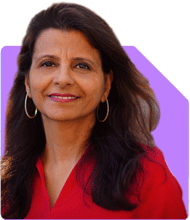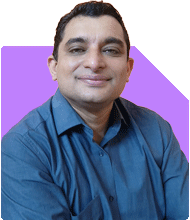Komal Jethmalani | Answer |Ask -Follow
Dietician, Diabetes Expert - Answered on Aug 25, 2021
She specialises in weight loss and diabetes management.
Jethmalani has completed her MSc in food and nutrition from SNDT University and trained at Jaslok Hospital.
She is a NDEP-certified diabetes educator.... more

Hi Komal
This is Pramila -- height: 5.4; weight: 58kgs, age: 36 years.
I am a working woman and sit for around 7-8 hours daily.
I am in sound health but I have a fat belly and fat thighs.
I do all the household chores.
I do a 10 minute brisk walk while going to office rather hiring an auto.
Sometimes, I run to catch a train also. Still, my belly fat is not reducing.
I am a pure vegetarian. I eat fresh cooked food, all type of vegetable, fruits and nuts. But daily I eat different biscuits.
I visited a doctor for pigmentation marks on my face. The doctor said I have nutrition issues.
Please help.
Thank you so much.
Pramila Nayak
Fitness is attained with nutrition and exercise.
Doing regular household chores and short walks unfortunately does not contribute to fat burning.
Body fat can be shed by strength and endurance training wherein muscle build up and fat loss is the target.
Cardio activities are essential as well along with this.
Immobility for long periods does cause fat deposition in the most vulnerable areas of our body like belly and hips, where women have a high fat percentage.
Biscuits are generally made of refined flour and processed fat which contribute unhealthy and harmful transfats to our body. The high carbohydrate and sodium content will increase the risk of lifestyle disorders
So follow a healthy lifestyle devoid of excess carbs and fat, plus align yourself towards a fitness goal.
You may like to see similar questions and answers below
Komal Jethmalani | Answer |Ask -Follow
Dietician, Diabetes Expert - Answered on Sep 13, 2021
Komal Jethmalani | Answer |Ask -Follow
Dietician, Diabetes Expert - Answered on Dec 06, 2023
Dr Shakeeb Ahmed Khan | Answer |Ask -Follow
Physiotherapist - Answered on Mar 29, 2024
Dr Shakeeb Ahmed Khan | Answer |Ask -Follow
Physiotherapist - Answered on Apr 12, 2024
Dr Dipankar Dutta |1837 Answers |Ask -Follow
Tech Careers and Skill Development Expert - Answered on Dec 05, 2025
Dr Shyam Jamalabad |108 Answers |Ask -Follow
Dentist - Answered on Dec 05, 2025
Dr Shyam Jamalabad |108 Answers |Ask -Follow
Dentist - Answered on Dec 05, 2025
Dr Shyam Jamalabad |108 Answers |Ask -Follow
Dentist - Answered on Dec 05, 2025
Dr Dipankar Dutta |1837 Answers |Ask -Follow
Tech Careers and Skill Development Expert - Answered on Dec 05, 2025
Ulhas Joshi |280 Answers |Ask -Follow
Mutual Fund Expert - Answered on Dec 05, 2025
Dr Dipankar Dutta |1837 Answers |Ask -Follow
Tech Careers and Skill Development Expert - Answered on Dec 04, 2025
Ravi Mittal |676 Answers |Ask -Follow
Dating, Relationships Expert - Answered on Dec 04, 2025
Anu Krishna |1745 Answers |Ask -Follow
Relationships Expert, Mind Coach - Answered on Dec 04, 2025
Anu Krishna |1745 Answers |Ask -Follow
Relationships Expert, Mind Coach - Answered on Dec 04, 2025
Close


























